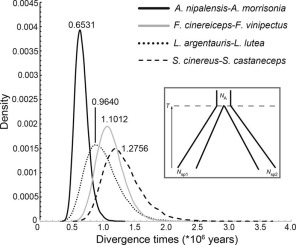当前位置:
X-MOL 学术
›
Mol. Phylogenet. Evol.
›
论文详情
Our official English website, www.x-mol.net, welcomes your
feedback! (Note: you will need to create a separate account there.)
Secondary contact after allopatric divergence explains avian speciation and high species diversity in the Himalayan-Hengduan Mountains.
Molecular Phylogenetics and Evolution ( IF 3.6 ) Pub Date : 2019-11-07 , DOI: 10.1016/j.ympev.2019.106671 Feng Dong , Chih-Ming Hung , Xiao-Jun Yang
Molecular Phylogenetics and Evolution ( IF 3.6 ) Pub Date : 2019-11-07 , DOI: 10.1016/j.ympev.2019.106671 Feng Dong , Chih-Ming Hung , Xiao-Jun Yang

|
The geographical context of speciation is important for understanding speciation and community assembly. However, the predominant mode of speciation in the Himalayan-Hengduan Mountains (HHMs), a global biodiversity hotspot, remains unknown. Here, we examined the role of geography in speciation using four pairs of sister or closely related avian species that currently co-occur in the HHMs. While multilocus network analyses based on nine to eleven genes revealed deep splits between these species, several allelic networks based on individual loci suggested phylogenetic paraphyly implying a recent history of divergence. Following extensive sampling in the contact zones of these species pairs, the coalescence-based approximate Bayesian computation approach supported no gene flow during their divergence and was consistent with an allopatric speciation model. We further estimated the divergence times of the four species pairs during the middle and late Pleistocene, which were characterized by increased amplitudes of glacial variability. We found a positive relationship between their divergence times and current sympatry levels, supporting a scenario of secondary contact following allopatric speciation. The Pleistocene glacial-interglacial cycles may have led to the initial geographic population isolation; ecological divergence or mate choice might further accelerate their differentiation during secondary contact, facilitating their speciation and species accumulation in the mountainous landscape. Our findings reveal the critical role of geographic isolation in speciation in the HHMs and shed light on how this biodiversity hotspot aggregates numerous species.
中文翻译:

异源扩散后的二次接触解释了喜马拉雅-横断山脉的鸟类物种形成和物种高度多样性。
物种形成的地理环境对于理解物种形成和社区聚集非常重要。但是,全球生物多样性热点地区喜马拉雅-横断山脉(HHMs)的主要物种形成方式仍然未知。在这里,我们使用目前在HHM中同时出现的四对姊妹或密切相关的鸟类物种,研究了地理在物种形成中的作用。虽然基于9到11个基因的多基因座网络分析揭示了这些物种之间的深层分裂,但基于单个基因座的几个等位基因网络却暗示着系统发育上的系统性暗示了最近的发散历史。在对这些物种对的接触区进行大量采样之后,基于聚结的近似贝叶斯计算方法在它们的发散过程中不支持基因流,并且与异源物种形成模型一致。我们进一步估计了更新世中期和晚期这四个物种对的发散时间,其特征是冰川变异性的幅度增加。我们发现它们的发散时间与当前的对称性之间呈正相关,支持了异源物种形成后的二次接触。更新世的冰间期循环可能导致了最初的地理种群隔离。生态多样性或伴侣的选择可能会进一步促进它们在次生接触中的分化,从而促进它们在山地景观中的物种形成和物种积累。
更新日期:2019-11-08
中文翻译:

异源扩散后的二次接触解释了喜马拉雅-横断山脉的鸟类物种形成和物种高度多样性。
物种形成的地理环境对于理解物种形成和社区聚集非常重要。但是,全球生物多样性热点地区喜马拉雅-横断山脉(HHMs)的主要物种形成方式仍然未知。在这里,我们使用目前在HHM中同时出现的四对姊妹或密切相关的鸟类物种,研究了地理在物种形成中的作用。虽然基于9到11个基因的多基因座网络分析揭示了这些物种之间的深层分裂,但基于单个基因座的几个等位基因网络却暗示着系统发育上的系统性暗示了最近的发散历史。在对这些物种对的接触区进行大量采样之后,基于聚结的近似贝叶斯计算方法在它们的发散过程中不支持基因流,并且与异源物种形成模型一致。我们进一步估计了更新世中期和晚期这四个物种对的发散时间,其特征是冰川变异性的幅度增加。我们发现它们的发散时间与当前的对称性之间呈正相关,支持了异源物种形成后的二次接触。更新世的冰间期循环可能导致了最初的地理种群隔离。生态多样性或伴侣的选择可能会进一步促进它们在次生接触中的分化,从而促进它们在山地景观中的物种形成和物种积累。











































 京公网安备 11010802027423号
京公网安备 11010802027423号